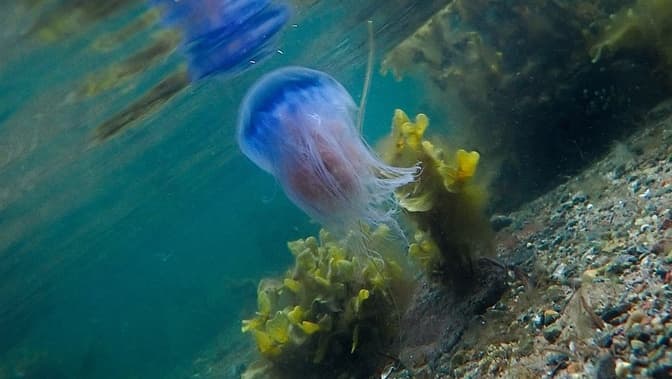Blue jellyfish have appeared on the west coast again. Only during the month of June, many more have been reported than in previous summers.
You have to be on the lookout: The threads can be a couple of meters, says Doris Björling, jellyfish researcher at the University of Gothenburg.
Besides the red jellyfish and the harmless ear jellyfish, the blue jellyfish is found along the west coast this year. It's not uncommon, but the number varies from year to year.
The blue jellyfish thrives in saltwater and is found on the west coast. From the Halmstad area and all the way up to Norway.
Burns on the "clock"
Both the red and blue jellyfish can cause burns. The red ones often get bigger and can be easier to burn from that reason. The red one only burns on the threads, while the blue one can burn on the "clock" as well.
There are different opinions about which one burns the worst. It probably depends on how much of the threads the person has gotten on themselves and how sensitive they are, says Doris Björling.
If you get burned
It's usually the threads that cause the burning sensation. When you get burned, you shouldn't use freshwater or soap on the affected area.
Freshwater and chemicals can trigger the tentacles in the threads, so it's best to go back into the saltwater again, says Doris Björling.
It can also be effective to scrape with a credit card or similar to remove the threads from the skin.
There are many household tips about urine and vinegar helping. But there is no evidence that it would work against jellyfish in Swedish waters.
More common in the future
The studies that have been done show that the blue jellyfish has good opportunities to become even more common with increased water temperature in the oceans, according to Björling.
But it can't be said for sure. Competition, currents, and food availability in the jellyfish's different life stages play a role.
The blue jellyfish, also called the blue compass jellyfish, can grow up to 30 cm in diameter. In Swedish waters, it rarely exceeds 15 cm.
The jellyfish's clock is clear blue to violet, with darker tones inside the stomach and lighter blue at the clock's edge. The clock can in exceptional cases also be pale yellow or grayish.
The blue jellyfish is found along Sweden's west coast and doesn't thrive in brackish and freshwater, unlike the red jellyfish.
The blue jellyfish lives near the water surface.
Source: National Encyclopedia/artfakta.se






